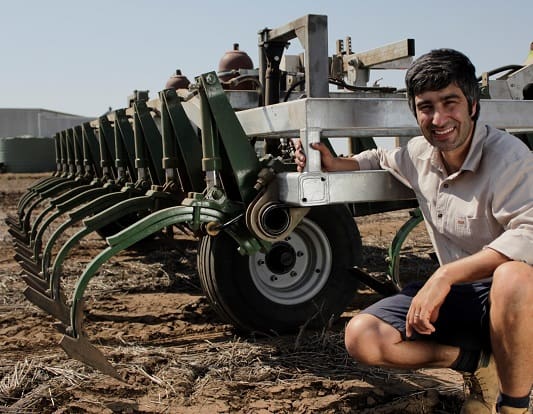
UWA School of Engineering agricultural engineer Andrew Guzzomi with the prototype mechanical weeding machine. (Photo: Ryan Early, Reflected Image Productions)
A PROTOTYPE mechanical weeding machine based on a conventional trashworker with breakout tynes and designed to target weeds in fallows could open up new options for growers in the fight against hard-to-kill, herbicide-resistant weeds.
Developed by agricultural engineers and researchers from the University of Western Australia (UWA) and the University of Sydney, with Grains Research and Development Corporation (GRDC) investment, the aim of the project was to come up with a low cost, targeted tillage device that operated at 10 kilometres/hour with minimal soil disturbance.
UWA School of Engineering agricultural engineer Andrew Guzzomi told the GRDC Research Update in Perth the machine featured a cultivator bar where tynes were raised above the ground in a standby position, ready to chip the weeds out of the ground the moment they were detected with weed-sensing technology.
“The idea is to hold the tyne in a standby position just above the ground. When a weed is sensed, the tyne is triggered to engage with the soil, then returns to the standby position,” he said.
The ‘rapid response’ tyne system is designed to chip out weeds at densities of one plant per 10 square metres.

When a weed is sensed, the tyne is triggered to engage with the soil, remove the weed, then return to the standby position.
Dr Guzzomi said the groundbreaking technology would allow growers to control weeds in summer and winter fallows with greater flexibility in situations that restricted the use of herbicide application, such as wind, heat, surface temperature inversions and herbicide resistance.
“Its ability to handle a vast range of weeds, at varying growth stages, is likely to reduce the number of ‘passes’ required to manage fallow weeds, compared with current herbicide practices,” he said.
“This will help to mitigate its slower travel speed and narrower coverage, when compared with spray equipment.
“Another benefit is that the mechanical weeding machine’s periodic tilling action, that is appropriate for use in low-density weed population situations, will allow it to be coupled to low horsepower tractors.”
University of Sydney director of weed research Michael Walsh said the machine had effectively killed summer and winter annual weeds that had been targeted in field testing, regardless of the growth stage of the weeds.
“It is highly effective on both broadleaf and grass weeds, and soil disturbance is potentially low,” Dr Walsh said.
“With a significantly reduced need for follow-up herbicide use, the system is an efficient tactic suitable for inclusion in an integrated weed management system.”
The efficacy of the technology relies on accurate weed detection, with optical detection systems incorporated into the six-metre prototype.
In a bid to allow the technology to be made commercially available to growers, the project is moving into commercialisation.
It is at the stage where researchers are looking to farm-test the machine to see how it performs and to help them establish wear rates and potential fatigue issues, and tweak the sweep design.
Grain Central: Get our free cropping news straight to your inbox – Click here

HAVE YOUR SAY